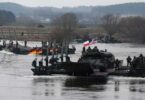COLOGNE (Defensenews): NATO heads of state and government will confront a sizable to-do list at their June 14 Brussels summit, as the event will set the path for hardening the alliance’s outer defenses while staying limber on the inside.
The summit will mark one of the first major in-person defense events after the global coronavirus pandemic began showing signs of ebbing. It will also be the first such gathering with U.S. President Joe Biden, whose predecessor had NATO officials worrying more about keeping the alliance together than composing a forward-looking agenda.
Deterrence is expected to be one of the major themes, as member states in Europe look to craft a message to Russia that NATO’s eastern flank is off limits to what they see as Moscow’s military adventurism.
To that end, leaders at the summit will consider how best to implement a key document, the classified Concept for Deterrence and Defence of the Euro-Atlantic Area, or DDA for short, drawn up by military planners. The plan is part of the core canon of NATO doctrine, tying together national strategies and modernization programs.
NATO’s easternmost members have shown a particular interest in seeing the concept put into practice through military heft. Russian forces are gearing up for the large-scale Zapad exercise this summer, which has former Soviet Union countries that are now part of the Western alliance on edge.
“From Estonia’s perspective, it’s important that the DDA will form the backbone of the alliance’s modernized deterrence and defense posture, providing the strategic framework necessary to deter and defend against all threats and ensure rapid and timely reinforcement of any ally,” Estonian Defence Minister Kalle Laanet told Defense News.
One idea pitched by the Baltic countries in recent years, expected to resurface at the summit, entails expanding the alliance’s air-policing mission on the northeastern flank into a broader air defense mission, including anti-missile weapons.
Strategic homework
The summit is also expected to formally order the production of a new NATO strategic concept, to conclude within a year. That work amounts to a wholesale revision of alliance guidance, to which member nations align their national defense plans. The most recent concept hails from 2010, predating Russia’s 2014 annexation of Crimea from Ukraine that changed the strategic calculus for European governments.
“The new strategic concept would be a milestone, as so many issues regarding threats and deterrence flow from it,” said German lawmaker Tobias Lindner, the Green Party’s point man for defense issues in the Bundestag.
The topic of deterrence — nuclear, that is — is expected to make a reprise in Germany following the federal election in late September, where the Greens have a shot at joining the next governing coalition, according to recent polls.
Whenever major defense questions come up in the country, Germany’s continued participation in NATO’s nuclear-sharing arrangement — meaning German Tornado aircraft carrying U.S. atomic bombs into a hypothetical war – ends up on the table.
While the Greens are known to reject nuclear weapons, their exact stance would probably be finalized only during actual coalition negotiations, Lindner told Defense News.
He predicted the party’s position will end up something like this: The Greens want Germany to get out of the nuclear weapons business, and by extension discuss the Tornado replacement strategy, but not in a way that would be disruptive to Berlin’s defense commitments.
China challenge
NATO leaders are also expected to advance the alliance’s thinking on China, a country where perceptions in Europe and the United States perhaps diverge the most. NATO’s 2019 London Declaration only refers to China as having “growing influence and international policies” that present “both opportunities and challenges.”
Beijing’s combination of economic, diplomatic and military means to pursue its global agenda has at times flummoxed Western analysts trained to think in the currency of hard power or, at best, hybrid conflicts.
One of the alliance’s strategies for keeping Chinese expansionist ambitions in check is to deepen relations with partner nations in the Asia-Pacific region. NATO Secretary General Jens Stoltenberg previously referred to the approach as flexing the alliance’s political muscle in the region while keeping the geographic center of gravity in the Euro-Atlantic area.
“We share the values of many of those Asia-Pacific partners, and we are a values-based military alliance,” Air Chief Marshal Stuart Peach, the chairman of the NATO Military Committee, said in an interview with Defense News. “Therefore, working with them in this world, which is, let’s say, disturbed, seems to make sense to us. It can take many forms: partnership on missions, partnership on exercises, mutual maritime support, working together on cyber resilience.”
Peach expects the summit to provide new guidance on “the general direction of travel” when it comes to implementation.
“There isn’t a defined, finite list of activities,” he said. “Some of it will depend on their ambition and on our ambition. Whatever political direction we’re given at the summit, we can match that with military partnership.”
In Europe, there has been something of a newfound interest in proving that countries can muster lengthy naval deployments to the region. The French military, for example, sailed its nuclear-powered submarine Emeraude through the South China Sea this year. Germany is expected to send a frigate this summer, though military leaders and diplomats in Berlin have reportedly been at odds over how overtly they want the trip to serve as a freedom-of-navigation operation in an area where multiple countries, including China, are butting heads over disputed territories.
Perhaps most visibly, a U.K. carrier strike group, with the new aircraft carrier Queen Elizabeth as the flagship, set sail toward the region on May 22. The trip is shaping up be something of a floating exercise platform for the kinds of ties that NATO wants to promote.
The China conundrum also manifests closer to home. Earlier this year, German Army Gen. Jorg Vollmer, who commands Allied Joint Force Command Brunssum, questioned whether NATO officials fully understand Beijing’s business involvement in Europe’s transportation infrastructure. Chinese companies have been snapping up shares in most of Europe’s major ports, for example, leading local planners to wonder if that could impede NATO’s military mobility during a conflict.
One of the tools for keeping abreast of Chinese influence over transportation and telecommunications infrastructure involves a data “dashboard” for mapping Chinese investments related to its Belt and Road Initiative, alliance officials told Defense News earlier this year. The dashboard system was designed to aggregate open-source information to serve as a decision-making tool for NATO planners.
“We are concerned about infrastructure ownership,” Peach said, adding that alliance officials are striving to deepening their understanding of what’s at stake. “Sometimes ownership isn’t absolutely clear. We will continue to study this issue, and we will also continue to respond in terms of mobility and resilience.”






